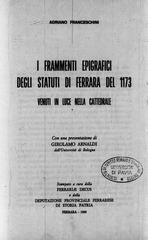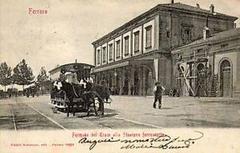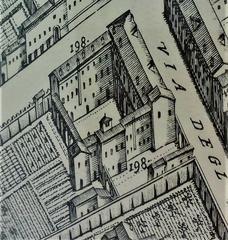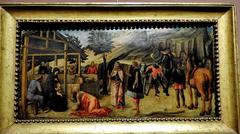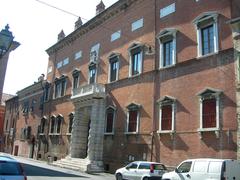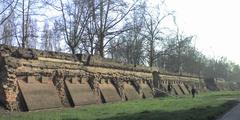Baluardo di Santa Maria della Fortezza, Ferrara, Italy: Visiting Hours, Tickets, and Travel Guide
Date: 14/06/2025
Introduction
The Baluardo di Santa Maria della Fortezza is a striking remnant of Ferrara’s Renaissance military architecture, embodying centuries of political, architectural, and cultural transformation. Situated within Ferrara’s UNESCO-listed city walls, this pentagonal bastion invites exploration by history enthusiasts, architecture lovers, and casual visitors alike. This comprehensive guide covers the site’s history, architectural features, visitor information, and practical tips to help you make the most of your visit to one of Ferrara’s most iconic landmarks (Museo Ferrara; Listone Mag).
Table of Contents
- Historical Overview
- Architectural Features
- Strategic and Cultural Significance
- Visiting Information
- Accessibility and Visitor Services
- Events and Community Engagement
- Nearby Attractions
- Photography and Scenic Views
- Sustainability and Preservation
- Frequently Asked Questions (FAQ)
- Practical Tips
- References
Historical Overview
Origins and Political Context
The Baluardo di Santa Maria della Fortezza, alongside the Baluardo di San Paolo, is a surviving part of the once-massive Fortezza Pontificia. Its construction arose from a pivotal moment in Ferrara’s history: the city’s transition from Este family rule to papal control after Duke Alfonso II d’Este died without an heir in 1597. Seeking to assert papal authority and repel external threats, Pope Clement VIII initiated the fortress’s construction as both a military safeguard and a political statement (Listone Mag).
Design and Construction
Between 1608 and 1618, the fortress was built following the “star fort” model, a cutting-edge design of the era. Architects such as Giovan Battista Aleotti, Mario Farnese, and Pompeo Targone contributed to the pentagonal layout comprising five bastions: Santa Maria, San Paolo, Sant’Antonio, San Pietro, and San Tommaso. Advanced defensive features included thick brick ramparts, deep moats, ravelins, and underground galleries, all reshaping Ferrara’s urban landscape and displacing entire neighborhoods (Ferrara Terra e Acqua).
Evolution and Decline
While the fortress remained a strategic site into the 19th century, its importance faded after Italian unification. Most of the complex was demolished to make way for urban expansion, leaving only the bastions of Santa Maria and San Paolo as enduring witnesses to the city’s martial past.
Architectural Features
Bastion Design and Innovations
The Baluardo di Santa Maria exemplifies Renaissance military engineering. Its pentagonal shape and angular bastions allowed for interlocking fields of fire, minimizing blind spots and maximizing defensive capability—a hallmark of the trace italienne system. Built with brick and earth, the bastion’s thick, sloped walls absorbed and deflected artillery fire. Casemates for cannons, powder magazines, and storage rooms were integrated within the bastion, while the fortress’s main gates featured marble elements and protective ravelins (Listone Mag).
Surviving Elements
Today, visitors can observe the bastion’s embankments and the statue of Pope Paul V, sculpted by Giovanni Lucca. The church of Santa Maria dell’Annunziata, once part of the fortress, was destroyed during World War II, but the site retains significant architectural vestiges and interpretive signage (Ferrara Info).
Strategic and Cultural Significance
Power and Urban Impact
The fortress was deliberately oriented to dominate both the city and its approaches, functioning as an instrument of papal power and a deterrent against internal unrest. Its construction required the demolition of medieval neighborhoods, profoundly altering Ferrara’s urban fabric and displacing thousands (Listone Mag).
Artistic and Symbolic Features
The Baluardo was not only a military structure but also a symbol of authority. The statue of Pope Paul V, originally placed at the fortress’s center, underscored the religious and political ties of the site. The integration of the bastion with Ferrara’s broader system of Renaissance walls demonstrates the city’s evolution from medieval to early modern fortifications (Ferrara Terra e Acqua).
Visiting Information
Hours and Admission
- Open: Daily, year-round from dawn until dusk. Special events may extend hours into the evening.
- Admission: Free for all visitors; no tickets required for entry. Guided tours or special events may incur a fee (Comune di Ferrara).
Location and Getting There
- Address: Viale IV Novembre, Quartiere Giardino, Ferrara.
- Access: Easily reachable on foot or by bicycle from the city center. Public transport and limited parking are available nearby. Ferrara’s compact layout and extensive cycling network make non-motorized access especially convenient.
Amenities
- Restrooms: Available during major events; otherwise limited.
- Food and Drink: Food stalls operate during festivals; nearby cafés serve local cuisine.
- Information: Updates on events and visiting details are posted on the Comune di Ferrara website and @giardinipertutti.
Accessibility and Visitor Services
- Accessibility: Main paths are accessible to wheelchairs and visitors with limited mobility; some historic areas may be uneven.
- Guided Tours: Offered during festivals or by arrangement with the Ferrara tourist office. Self-guided visits are enhanced by interpretive panels in multiple languages (Ferrara Info).
- Family-Friendly: The park and bastion are safe environments; children should be supervised near embankments.
Events and Community Engagement
Cultural Revival
The Baluardo has been reimagined as a cultural and social hub, hosting events such as the annual “Un’Altra Fortezza” festival. This week-long celebration features performances, open-air cinema, theater, and dance, reflecting the site’s ongoing evolution from fortress to community asset (Comune di Ferrara).
Community Participation
Programming and event planning involve local residents and organizations, ensuring the Baluardo remains a living monument that bridges Ferrara’s past and present.
Nearby Attractions
The Baluardo’s central location makes it an excellent starting point for exploring:
- Parco Massari: Landscaped park with ancient trees and sculptures.
- Castello Estense: Ferrara’s iconic moated castle.
- Chiesa di San Cristoforo alla Certosa: Monumental church and cemetery.
- Historic Center: UNESCO-listed area with Renaissance palaces and vibrant piazzas (Ferrara Terra e Acqua).
Cycling or walking along the city’s 9-kilometer circuit of walls is a popular way to experience Ferrara’s urban landscape.
Photography and Scenic Views
The bastion’s elevated position offers panoramic views of Ferrara’s skyline, parks, and Renaissance cityscape. The interplay of historic brickwork, natural light, and seasonal foliage creates excellent opportunities for photography throughout the year.
Sustainability and Preservation
The Municipality of Ferrara and local heritage organizations collaborate to maintain and preserve the Baluardo, balancing conservation with public access. Visitors are encouraged to respect posted guidelines and participate in community events supporting Ferrara’s historical legacy (Comune di Ferrara).
Frequently Asked Questions (FAQ)
Is there an entrance fee?
- No, entry to the Baluardo and park is free.
What are the visiting hours?
- Open daily from dawn to dusk. Event hours may vary.
Are guided tours available?
- Yes, during festivals or by arrangement.
Is the site accessible for visitors with limited mobility?
- Most paths are accessible; some uneven terrain exists.
How do I get there?
- Walk, cycle, or use public transportation from Ferrara’s city center; limited parking nearby.
Practical Tips
- Wear comfortable shoes for walking or cycling.
- Bring water and snacks, especially outside event periods.
- Check weather conditions as most of the site is outdoors.
- Visit during spring or autumn for mild weather and vibrant scenery.
- Respect historic structures and natural areas during your visit.
References and Official Sources
- Museo Ferrara - Baluardo di Santa Maria
- Listone Mag - Storia di una fortezza controversa
- Comune di Ferrara - Un’Altra Fortezza
- Ferrara Terra e Acqua - Ferrara and its wall
- Ferrara Info
- The Crazy Tourist - Best things in Ferrara
- UNESCO - Ferrara, City of the Renaissance
Plan Your Visit and Stay Connected
To enhance your visit, download the Audiala app for interactive maps and audio guides, and follow @giardinipertutti or check the Comune di Ferrara website for updates on events and guided tours.
